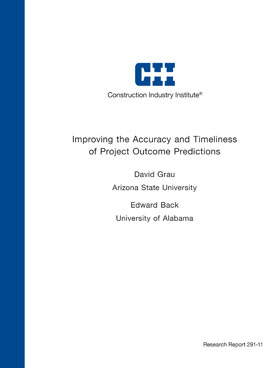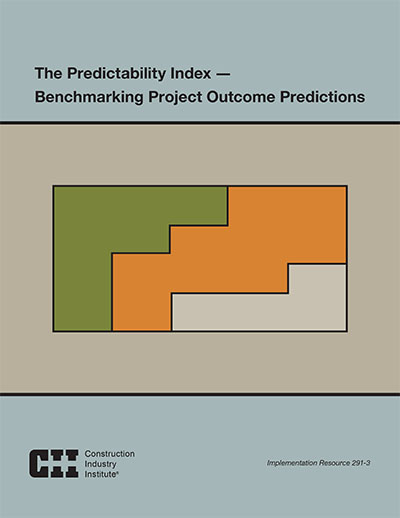
Improving the Accuracy and Timeliness of Project Outcome Predictions, Version 1.1
Seeking to continually improve the project delivery process, the Construction Industry Institute initiated Research Team 291, Improving the Accuracy and Timeliness of Project Outcome Predictions, to address the myriad challenges to reliably predicting project outcomes. Making any prediction of future performance, particularly with respect to final cost and schedule, is a difficult endeavor. Owners and contractors alike base key strategic decisions on their project forecasts, and typically ask project teams to continually refine cost and schedule predictions with the goal of providing management with valid, timely, and reliable information. However, the ability to accurately predict project outcomes is highly varied within the industry, sometimes even within a single organization; this variability means that all too often, many companies experience “surprises” or unexpected negative consequences.
As a key departure from previous CII research studies and other investigations on predictability, this research did not focus primarily on quantitative forecasting methods to predict outcomes. Instead, the research team concluded that project outcome predictability is actually influenced by factors across multiple core competencies intrinsic to capital project delivery. Moreover, the team found that the processes and tools used to generate, communicate, and revise a project’s cost and schedule forecasts are as diverse as any other assessment or evaluation undertaken within the industry. However, the research revealed that there were distinct and identifiable practices, that when implemented, distinguished effective project from ineffective ones, with respect to their ability to forecast final cost and schedule outcomes. The team found that these practices fall into four categories: 1) human behavior and organizational culture; 2) project characteristics; 3) forecasting practices; and 4) management processes. Of these, the practices within the human behavior and organizational culture category were statistically shown to have the greatest influence on predictability. Using this four-category structure, the team developed its Four-casting model to sustain the implementation of the predictability-enhancing practices. The Four-casting model is presented in Implementation Resource (IR) 291-2, Four-casting for Early and Accurate Predictability. To facilitate industry adoption of this model, IR 291-2 addresses each of the four practice categories in separate chapters. Each chapter provides key “take away” findings, a list of potential predictability “de-railers,” and mitigation actions. The team also produced the Excel-based Four-casting assessment tool to enable project teams to continuously evaluate the effectiveness of their predictability processes during a project, and to identify the categories and predictability practices in the Four-casting model that require attention.
In addition to finding and categorizing predictability-improving practices, the research team identified the types of changes that negatively affect the predictability of cost and schedule outcomes. These statistical findings indicate that the disruptive nature of change on owner and contractor project performance presents itself in varied form, frequency, and intensity. The team identified a total of 36 change reasons, grouping them into 10 types of change: 1) scope changes; 2) standard, regulatory, and legal requirements; 3) engineering design; 4) work planning and execution; 5) commissioning and start-up; 6) control functions; 7) vendor/supplier and procurement; 8) economic conditions; 9) legal and social conditions; and 10) force majeure. For owners, changes associated with scope, work planning, and execution disrupt predictability the most, while for contractors, changes associated with scope and control functions were statistically found to be the most disruptive. Also, the results provide quantitative evidence to support the long-held perception that highly recurrent changes tend to have a low impact on cost and schedule deviations, while infrequent changes tend to have a high impact on such deviations. These findings on change reasons are also detailed in IR 291-2.
The research also provides strong evidence that, because early and accurate predictions enable proper management decisions, the ability to proactively predict project outcomes increases value to the organization. Indeed, project team performance should be evaluated on the basis of a project team’s ability to mitigate cost and schedule deviations through the early and accurate prediction of cost and schedule outcomes, as opposed to the now prevalent evaluation of a team’s performance based solely on the magnitude of such deviations at project completion. To support the need to measure the predictability of project outcomes, the team also conceptualized, validated, and produced the Predictability Index, a novel project performance metric that enables owner and contractor organizations to quantitatively benchmark and individually assess the predictability performance of their completed projects. IR 291-3, The Predictability Index, explains the research behind this metric and how to use its corresponding Excel-based measurement tool.
The outcomes of this research show predictability to be an effective risk mitigation and value-increasing mechanism. As a departure from existing risk management approaches that largely rely on the identification of potential risks, RT 291 presents a novel set of predictability practices that will facilitate accurate forecasts early in the project delivery process. Project teams cannot eliminate surprises, but they can mitigate the potential negative effects of such surprises with the early recognition and the early documentation of them. Such early awareness of the effects of external and internal events helps project teams and the organizations they work for make better well-informed management decisions, at both the project and portfolio levels. Early predictability adds value by enabling the proper response to surprises and changes. Project managers who can foresee impending cost and schedule deviations can mitigate the causes by assigning the right people, implementing the right processes, and encouraging the right behaviors.
Predictability, the condition to produce early and accurate forecasts for cost and schedule measures at completion and needs to have a high degree of accuracy and reliability in order to have meaningful benefit to the sponsoring organizations.
The research team concluded that the processes and tools utilized to generate, communicate, and revise a project’s cost and schedule forecast are as diverse as any other techniques used within the profession to address challenges. Importantly however, the research revealed that there were distinct and identifiable differences between effective and ineffective projects with respect to the practices they use to forecast final cost and schedule outcomes. The research team categorized these practices as follows:
- Human behavior and organizational culture
- Project characteristics
- Forecasting practices
- Management processes
These four categories form the basis of the team’s Four-casting model. Of the four, human behavior and organizational culture was the category statistically shown to have the greatest influence on predictability. The four categories of practices are presented in detail in IR291-2 including key “takeaway” findings, a list of potential predictability “derailers,” and recommended mitigation actions.
Project team performance needs to be evaluated based on the team’s ability to mitigate cost and schedule deviations through the early and accurate prediction of cost and schedule outcomes, as opposed to the prevalent evaluation of a team’s performance based solely on the magnitude of such deviations at project completion.
RT-291 developed a numerical index to measure cost and schedule predictability performance. This resource, the Predictability Index, indicates a project team’s past ability to proactively and effectively address the events and surprises that have affected the accuracy and timeliness of its forecasts. Indeed, project teams cannot eliminate surprises (or all bad news), but they can—and should—mitigate the effect of such surprises with their early recognition, transparent and candid reporting, and full appreciation of the events that influence effective forecasting. To this end, project stakeholders are strongly encouraged to consider the importance of human behavior and organizational culture as explained in the research findings and as emphasized in the proposed predictability practices. (RS291-1, p. 47)The disruptive nature of change on owner and contractor project performance presents itself in varied form, frequency and intensity. While some companies categorize changes through many individual change reasons grouped into key types of change, others choose to catalog changes through only a few individual reasons. Reported change reasons also reflected the different approaches to business taken by distinct industry sectors. Differences were also observed between owner and contractor organizations:
- For owners, changes associated with scope, work planning and execution disrupt predictability the most
- For contractors, changes associated with scope and control functions were found to be the most disruptive
In its effort to categorize changes that affect predictability, the team identified 36 distinct change reasons, grouped into 10 types of change: (RS291-1, p. 33)
- Scope changes
- Standard, regulatory, and legal requirements
- Engineering design
- Work planning and execution
- Commissioning and start-up
- Control functions
- Vendor/supplier and procurement
- Economic conditions
- Legal and social conditions
- Force majeure



